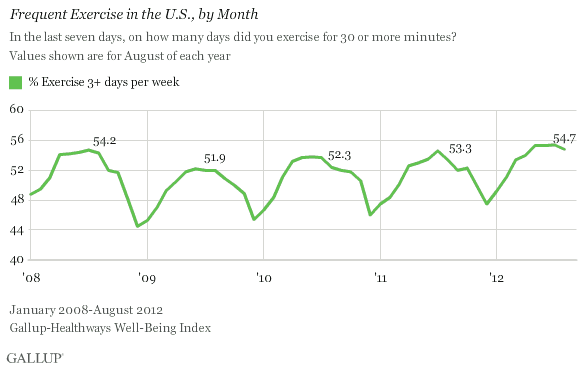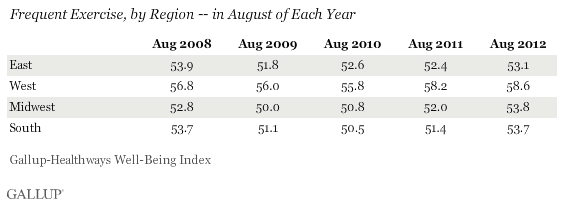WASHINGTON, D.C. -- More Americans exercised frequently in August (54.7%) than did in the same month in past years -- continuing a pattern Gallup and Healthways have found through most of 2012. In every month this year, except for April, more Americans reported exercising three or more days per week than did so in the same month for each of the past four years.

Gallup and Healthways ask 1,000 American adults daily about their exercise habits as part of the Gallup-Healthways Well-Being Index. Specifically, Americans report how many days in the past seven they exercised for at least 30 minutes.
The uptick in frequent exercise this year has come amid "the warmest first eight months of any year on record" in the U.S., according to the National Oceanic and Atmospheric Administration. Whether there is a direct relationship between these warm temperatures and higher exercise levels -- or it is mere coincidence -- is not certain.
However, that Americans' exercise habits are seasonal -- they work out more in the spring and summer months and less in the fall and winter -- points to the weather playing a role in their likelihood of exercising.
Frequent Exercise Up in All Regions
Americans in all regions of the country were more likely to exercise frequently this August than they were in the same month in 2009, 2010, and 2011. However, residents in the East and West were no more likely to exercise frequently this August than they were in August 2008.

Bottom Line
Although frequent exercise will decline as fall and winter set in, if the current trend continues, 2012 may end up being a record year for exercise in the U.S. And, even though the changes are small, for a nation grappling with a dangerous and costly obesity issue, every little bit of movement in the right direction in terms of improving health habits can have an impact. Additionally -- and ideally -- as more Americans pick up better exercise habits, they could inspire or intentionally spur others to action -- their coworkers, spouses, children, classmates, and neighbors.
But, if the increase in exercise is tightly tied to warmer-than-average temperatures, it is unclear whether Americans will sustain or improve upon the current higher levels in future years. Gallup and Healthways' ongoing measurement of Americans' exercise habits will help reveal how this plays out in the months and years ahead.
About the Gallup-Healthways Well-Being Index
The Gallup-Healthways Well-Being Index tracks well-being in the U.S., U.K., and Germany and provides best-in-class solutions for a healthier world. To learn more, please visit well-beingindex.com.
Survey Methods
Results are based on telephone interviews conducted as part of the Gallup-Healthways Well-Being Index survey Aug. 1-31, 2012, with a random sample of 31,364 adults, aged 18 and older, living in all 50 U.S. states and the District of Columbia, selected using random-digit-dial sampling.
For results based on the total sample of national adults, one can say with 95% confidence that the maximum margin of sampling error is ±1 percentage point.
Interviews are conducted with respondents on landline telephones and cellular phones, with interviews conducted in Spanish for respondents who are primarily Spanish-speaking. Each sample includes a minimum quota of 400 cell phone respondents and 600 landline respondents per 1,000 national adults, with additional minimum quotas among landline respondents by region. Landline telephone numbers are chosen at random among listed telephone numbers. Cell phone numbers are selected using random-digit-dial methods. Landline respondents are chosen at random within each household on the basis of which member had the most recent birthday.
Samples are weighted by gender, age, race, Hispanic ethnicity, education, region, adults in the household, and phone status (cell phone only/landline only/both, cell phone mostly, and having an unlisted landline number). Demographic weighting targets are based on the March 2010 Current Population Survey figures for the aged 18 and older non-institutionalized population living in U.S. telephone households. All reported margins of sampling error include the computed design effects for weighting and sample design.
The Life Evaluation Index is based on the Cantril Self-Anchoring Striving Scale, which asks respondents to evaluate their present and future lives on a scale with steps numbered from 0 to 10, where "0" is the worst possible life and "10" is the best possible life. Those who rate today a "7" or higher and the future an "8" or higher are considered to be "thriving." Those who rate today and the future a "4" or lower on the scale are considered to be "suffering." The overall Life Evaluation Index score is calculated as the percentage of thriving Americans minus the percentage of suffering Americans.
In addition to sampling error, question wording and practical difficulties in conducting surveys can introduce error or bias into the findings of public opinion polls.
For more details on Gallup's polling methodology, visit https://www.gallup.com/.
